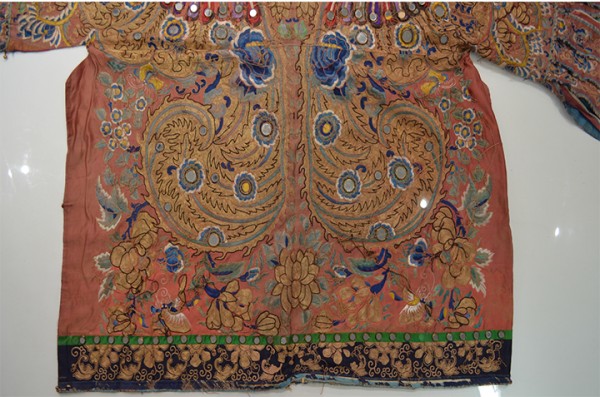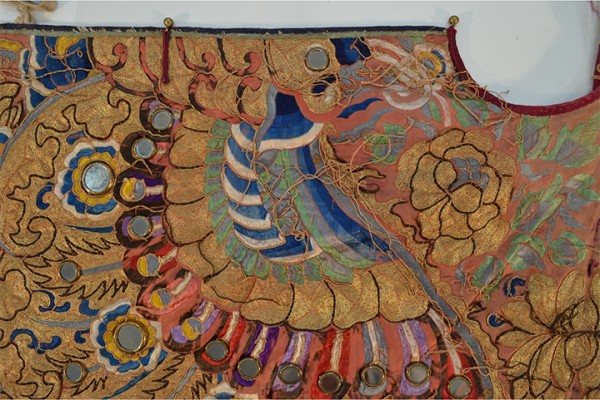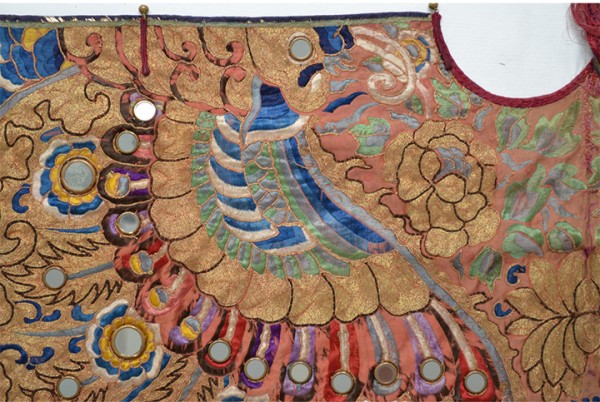Conservation Stories: Butterfly Robe Progress
There is a slim number of intricately designed Chinese theatrical costumes in American collections. That fact, along with the magnificence of this robe, made Scripps College’s 19th-century Beijing opera theater costume an essential candidate for conservation. In 2013, the National Endowment for the Arts (NEA) awarded Scripps a conservation grant for the treatment of this decaying robe. The piece underwent conservation by textile conservator Yadin Larochette, to preserve its educational value and historical aesthetics. Successful conservation makes the loan of the robe possible to academic exhibitions and other institutions to increase students’ and scholars’ knowledge of Asian textiles. This particular opera robe represents an important example of aristocratic-sponsored theater, and can be studied in comparison to other examples in theatre exhibitions. The tangibility of the textile plays an invaluable role in students’ educations. Access to the robe in its entirety allows for greater ease in contextualizing the cultural, economic, and historic elements of the textiles.
The costume is designed as a woman’s overcoat with a loose, open structure to represent the Han style. The satin robe is reversible with the outside in white, the inside in red, both displaying detailed embroidery. In a previous article on the website, (http://rcwg.scrippscollege.edu/conservation-stories-butterfly-robe), there is an initial description of the poor condition of the robe. The embroidery was fraying, the mirror embellishments cracked, and the robe too fragile to be exhibited or studied.
Four areas of conservation were noted in a progress treatment report from 2014, conducted by Larochette. First, an adjustable suction vacuum cleaned the surface of the robe’s four fabric layers through a polyester net. Using denatured alcohol on cotton swabs, Larochette cleaned the mirror embellishments embroidered on the white satin. Additionally, a polyester film with a special adhesive stabilized the cracked mirrors. A paper board support with a chemical mixture of acetone, alcohol, and 5% B72, secured deteriorating mirror fragments.
The following images show a “before and after” status of the current cleaning. The second image is after the initial treatments and shows a much cleaner and more defined version of the robe.

Proper right sleeve before securing metal threads

Proper right sleeve after securing metal threads
Conservation of the extensive metal thread embroidering is currently underway. Loose and broken threads have been stitched through the ground fabric layer to return them as close to their original position as possible. The embroidery on the red satin side of the robe, visible when the robe is open, has been completed and the embroidery on the white satin side is currently in progress. The first image is of the right shoulder of the robe before conservation. The tangled, detached mess of the colored threads shows the fragile state of the robe at that point. The second image is the same section of the garment after conservation. The metal threads have been secured, maintaining the aesthetic significance of the piece and preserving its structure.

Proper right shoulder at back before securing metal threads

Proper right shoulder at back after securing metal threads
The amount of care in recovering the needlework is significant, but necessary, for the embroidery of flowers and animals is important to study as it represents symbols understood within the society at the time. For example, the butterflies seen on both sides of the robe represent happy marriages and women’s romances. The butterflies sipping on the flower’s nectar symbolize erotic imagery, alluding to the butterfly as a lover and the flower as a female. The peonies indicate wealth and prominence. The conservation process rehabilitates the threads that have broken and thus disrupted the figurative symbolism in the robe. With the embroidery brought back to a close semblance of its original state, the robe’s function can be studied more critically.
Conserving this robe was vital to its use as a tool for education, for, without conservation, it would be too fragile to be handled. Access to it greatly enhances the learning experience for students. The exquisite workmanship, the vibrant colors, the feel of the cloth, and the monumentality of the piece cannot be communicated through images. The power of the symbolism of the elements and the effect of their synergy can be comprehended only by seeing the robe in its entirety. Thus, a full experience of this work of art can be realized solely in its presence. Time and again, students who have the opportunity for this multi-sensory experience find learning more engaging and richer. We are grateful to the NEA for supporting Scripps College in providing this type of deep learning to our students.

